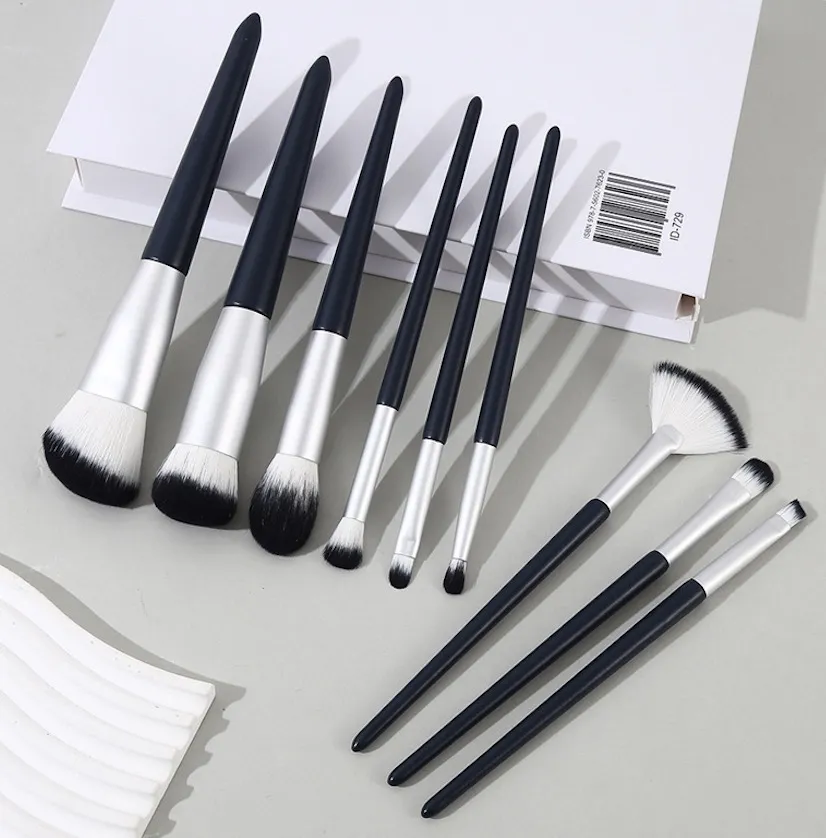Feeling overwhelmed by the endless options for makeup brushes? Choosing the wrong tools can lead to wasted inventory and poor results, a costly mistake for any growing beauty brand.
To choose the right makeup brushes, start with a 4-brush core1: a powder/blush brush, a foundation buffer, a flat shader, and a crease blender. Pick fibers by formula—natural for powders, synthetic for liquids—and clean them weekly to maintain performance and extend their lifespan.

Building the perfect brush line isn’t about offering the most tools; it’s about offering the right ones. Having spent years on the factory floor, I’ve seen firsthand what separates a good brush from a great one. It comes down to a few key decisions that I want to share with U. Let’s break down the essentials so U can source and sell brushes with confidence, creating a line that truly performs for your customers and your business.
The global makeup brush market is projected to reach approximately $2.6 billion by 2032.True
This is true. Market research from firms like Dataintelo and Valuates/QYResearch confirms strong, sustained growth in the category, making it a stable and promising market for beauty brands.
All synthetic makeup brushes are the same.False
This is false. The quality of synthetic filaments, like PBT or Taklon, varies greatly in softness, density, and how the tips are finished. High-grade synthetics can mimic natural hair, while low-grade ones can feel scratchy and perform poorly.
What Makeup Brushes Do You Actually Need? The 4-Brush Core Set (Plus Pro Add‑Ons)?
Your customers want a full-face look but don’t want to buy a 20-piece set. Offering too many options creates confusion and hurts sales. The solution is a core set that covers 90% of applications.
Start with a 4-brush core: a powder/blush brush, a synthetic foundation/cream brush, a flat shader for eyes, and a crease blender. This minimal set provides full-face functionality, making it perfect for beginners and incredibly efficient for brands to produce and market.

When I work with new brand founders, this is the exact strategy I recommend to balance cost, performance, and customer experience. It’s about SKU efficiency. Instead of launching with a dozen individual brushes, U can create a powerful, cost-effective starter kit that delivers real value. This core set is the foundation of any great brush line.
A Starter Set vs Pro Expansion
The "Core Four" handles the essentials. A large, fluffy powder brush sets makeup without looking cakey. A dense, synthetic foundation brush buffs liquid or cream formulas for a streak-free finish. A flat shader brush packs eyeshadow onto the lid with intensity. And a fluffy crease blender diffuses harsh lines for a seamless eye look.
Once your brand is established, U can introduce a "Pro Expansion" kit or sell specialized single brushes. I recommend adding three tools: an angled liner/brow brush for sharp details, a small, tapered highlighter brush for precise glow, and a larger angled face brush for bronzer and contour. This 7-piece collection covers over 90% of all common makeup looks while keeping your inventory lean and your brand story clear.
You need at least 10 different brushes to apply a full face of makeup.False
This is false. A core set of 3–4 versatile brushes can easily achieve a complete daily look. While pros use more for specialized techniques, it's not essential for the average consumer or a brand's starter collection.
A single medium-density angled face brush can be used for blush, bronzer, and contour.True
This is true. With the right technique—using the tip for contour, the flat side for bronzer, and the fluffy edge for blush—one brush can serve multiple purposes. This makes it a highly efficient and valuable tool in any collection.
Synthetic vs Natural Bristles: Pick by Formula, Finish, and Care?
Natural or synthetic? This choice feels complicated, with so much conflicting advice online. Picking the wrong fiber means poor makeup application, difficult cleaning, and brushes that don’t last. The solution is simple: match the fiber to the formula.
Use natural hair for powders and synthetic for liquids or creams. Natural bristles have microscopic cuticles that grip and diffuse powders beautifully. Smooth synthetic fibers don’t absorb liquids, ensuring a flawless, streak-free finish and much easier cleaning. Duo-fiber offers a versatile hybrid option.

The science is straightforward. Natural hair, like goat or squirrel, has a textured surface (the cuticle) that picks up and releases powder products gradually. This is perfect for blending eyeshadow or applying a soft wash of blush. Synthetic bristles, usually made from PBT or Taklon, are perfectly smooth. They don’t soak up creams and liquids, so the product goes on your face, not into the brush. This also makes them more hygienic and durable.
Market Trends and Sourcing Notes
Today, many brand founders like U prioritize vegan and cruelty-free claims. The good news is that modern synthetic technology has come a long way. In my factory, we source specific synthetic filaments that are engineered to be incredibly soft and tapered to mimic the performance of natural hair, even with powders. When U’re sourcing, ask your supplier for their filament specifications. A good partner can provide high-performance vegan options without compromise. Duo-fiber brushes, which mix both natural and synthetic fibers, are also a great choice for achieving an airbrushed finish with liquid or cream products.
Natural hair brushes are always better quality than synthetic brushes.False
This is false. A high-grade synthetic brush can easily outperform a low-grade natural hair brush, especially with liquid formulas. Quality depends on the filament material, density, and overall construction, not just the source.
Verifiable Vegan and Cruelty-Free certifications are a key purchasing driver for consumers.True
This is true. Today's consumers are increasingly demanding ethical and sustainable products. For brand founders, having authentic certifications is no longer a 'nice-to-have'—it's a major competitive advantage that builds trust.
Brush Shapes & Densities: A Quick Map by Task and Finish?
A "powder brush" can be fluffy, dense, angled, or tapered. Which one is right? Using the wrong shape or density leads to patchy blush, streaky foundation, or unblended eyeshadow. Let’s map the tool to the task with a simple guide.
Match the shape to the task: use flat, dense brushes to pack on color; fluffy, rounded brushes to blend and diffuse; and angled brushes to sculpt and define. Density controls coverage—denser brushes give more coverage, while fluffier brushes give a sheerer, more natural finish.

I remember watching workers in my factory hand-shaping each brush head. The precise angle of a contour brush or the tapered dome of a blending brush isn’t random—it’s engineered for a specific result. This craftsmanship is what U should look for in a manufacturing partner. Understanding this logic helps U build a cohesive, functional line that empowers your customers to get great results. A simple table can make these choices clear for your team and your customers.
Brush-to-Product Mapping Table
| Brush Type | Product Formula | Desired Finish | Recommended Fiber |
|---|---|---|---|
| Large Fluffy Brush | Loose/Pressed Powder | Sheer, All-Over Setting | Natural or Soft Synthetic |
| Dense Buffer Brush | Liquid/Cream Foundation | Medium-Full, Streak-Free | Dense Synthetic/Duo-Fiber |
| Angled Face Brush | Powder Contour/Bronzer | Sculpted, Defined | Natural or Soft Synthetic |
| Tapered Dome Brush | Powder Highlighter | Precise, Targeted Glow | Natural or Soft Synthetic |
| Flat Shader Brush | Shimmer/Metallic Shadow | High-Impact Deposit | Firm Synthetic or Natural |
| Fluffy Crease Brush | Matte/Satin Shadow | Soft, Diffused Blend | Natural or Soft Synthetic |
The denser the brush, the better the application will be.False
This is false. Density must match the task. A very dense brush is great for buffing foundation but would apply blush or bronzer too heavily. A less dense, fluffy brush is better for a soft, diffused look.
A flat shader brush is designed to deposit a high concentration of eyeshadow onto the lid.True
This is true. Its firm, flat shape is ideal for packing on pigment, especially shimmers and metallics, with minimal fallout. This is a task a fluffy blending brush cannot do as effectively.
How Often Should You Clean Makeup Brushes? Pro Hygiene SOPs?
Dirty brushes cause breakouts and muddy makeup application. But cleaning them the wrong way can ruin your investment, causing bristles to shed and handles to crack. I’ll share the factory-standard SOP for cleaning that protects your brushes.
Clean your most-used face and eye brushes weekly. Use a gentle cleanser, and crucially, avoid getting water inside the ferrule (the metal part connecting the handle and bristles). Reshape the bristles while damp and lay brushes flat to dry to maintain their shape and lifespan.

Protecting the ferrule is the most important step that most people miss. It’s where the bristles are held together with a strong adhesive. If water gets in, it weakens the glue, leading to shedding. This is why U should never dry your brushes upright in a cup. We advise all our clients to include a small care card with their brush sets. It’s a simple addition that reduces customer complaints, prevents returns, and reinforces the quality of your brand. It shows U care about the customer’s experience long after the purchase.
Buyer’s QC Checklist
When sourcing brushes, U need to ensure they can withstand regular cleaning. Ask your supplier about their quality control. Before we ship any bulk order, we perform tests to simulate real-world use. This includes a shed-rate test (tapping and stroking the brush to check for loose hairs) and a wash-cycle durability test, where we clean a sample brush 10+ times to ensure the ferrule stays secure and the handle’s finish doesn’t chip. U should demand this from any supplier to avoid the pain of receiving a bulk order that doesn’t live up to the sample.
You should dry your brushes upright in a cup to help them dry faster.False
This is false. Drying brushes upright allows water to seep into the ferrule, which weakens the glue and causes bristles to shed over time. Always dry brushes flat or angled downwards.
Regularly cleaning your makeup brushes can prevent breakouts and improve makeup application.True
This is true. Dirty brushes harbor bacteria, oil, and old makeup, which can clog pores and cause skin issues. Clean brushes also apply color more truly and blend more smoothly for a better result.
Conclusion
Choosing the right brushes comes down to matching fiber to formula, shape to task, and maintaining them with proper care. This strategic approach builds a better brand and happier customers.
References
-
Understanding the 4-brush core can help you streamline your makeup application and improve your beauty routine. ↩


